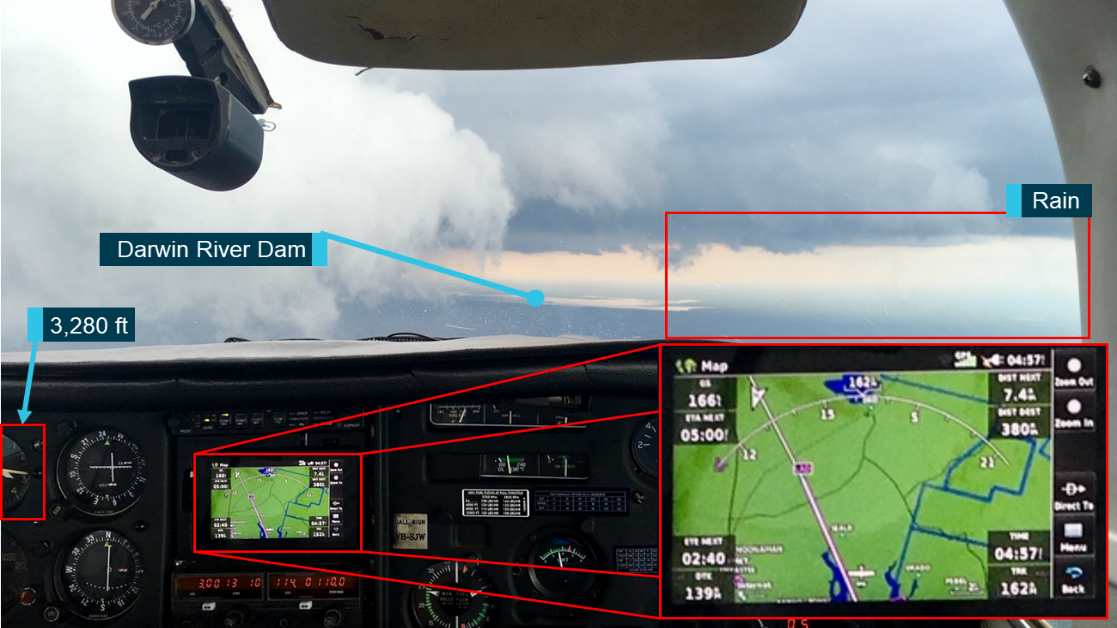
|
Key points:
|
Despite attempting to avoid a thunderstorm while flying in the Top End during the build-up, the pilot of a single-engine Cessna encountered sudden and sustained severe turbulence, resulting in a loss of control for an extended period and minor injuries to passengers.
The Cessna 210M, registered VH-SJW and operated by Mistar Holdings, was conducting a passenger charter flight with a pilot and four passengers on board from Darwin to Tindal, Northern Territory, on 25 November 2019. Soon after departure, the pilot diverted five nautical miles right of the planned track to avoid a large storm cell that was five nautical miles left of track.
While maintaining 3,500 feet, the aircraft encountered sudden and sustained severe turbulence. Control of the aircraft was lost for over three minutes, with the pilot having no control over bank angle, height or heading for extended periods. Radar at Darwin recorded the aircraft’s highest groundspeed as 210 knots, and rate of descent at one point to be 5,000 feet per minute with a lowest altitude of 1,200 feet.
Three of the passengers sustained minor injuries.
After landing safely at Tindal, the pilot inspected the Cessna for potential damage, before flying the aircraft for over an hour to Millingimbi to pick up four more passengers for a charter flight to Galiwin’ku (Elcho Island).
That evening, the pilot reported the incident to the operator who, upon receiving notification of the turbulence encounter, grounded the aircraft at Galiwin’ku, pending an engineering inspection.
This serious incident occurred just seven months after the ATSB published the final report from its investigation into the in-flight break up of another Cessna 210, which claimed the lives of two young pilots on 23 October 2017. The pilots had encountered severe turbulence while attempting to avoid thunderstorm activity to the east of Darwin during a flight to Galiwin’ku.
That investigation found a combination of airspeed, turbulence and control inputs probably led to excessive loading on the aircraft’s wings, which separated from the fuselage in-flight.
“These two investigations highlight the importance of recognising and avoiding tropical weather conditions that present significant hazards to flight,” ATSB Director Transport Safety Dr Mike Walker said.
“Identifying an appropriate distance to keep from thunderstorms, which comes through experience in operating in the tropics, can be particularly challenging for pilots.
“In many cases, deviations of 10 nautical miles may not be enough for an aircraft to remain safely clear of the turbulent and powerful forces associated with storms.”
The ATSB’s investigation into the 2019 occurrence also found that the operator did not have guidance to direct pilots to seek advice or peer support following abnormal events.
“Following the turbulence encounter, the inspection carried out by the pilot was not sufficient to ensure the airworthiness of the aircraft beyond doubt,” Dr Walker said.
“Flying another charter flight without an inspection by a qualified maintenance engineer exposed the operator, the pilot and the passengers to elevated risk.”
The investigation also highlights that the primary protection against thunderstorm related turbulence is avoidance, Dr Walker said.
“Operators, pilots and passengers can work together to avoid flying in adverse weather. For instance, by starting a day’s flying early it can be completed before weather becomes a problem typically in the afternoon.”
The investigation report notes that a pilot with the best intentions may make a suboptimal decision after experiencing an abnormal event.
“Operators can provide guidance to assist pilots to make good decisions in these situations, by providing peer support and emphasising the importance of reporting abnormal events in a timely manner,” Dr Walker said.
“Early reporting reduces pressure in operations, allowing ample time to make alternative arrangements.”
In October 2019, an ATSB Senior Transport Safety Investigator joined Aviation Safety Advisers from the Civil Aviation Safety Authority (CASA) in Darwin and Cairns to discuss with local pilots how to make more informed and rational decisions when managing the hazards associated with flying across the Top End during the build-up and wet seasons.
Later this evening [15 September 2020], CASA and the Bureau of Meteorology are holding a safety seminar in Darwin to again highlight the dangers of flying near thunderstorms for both general aviation and commercial pilots.
“Pilots should regularly review operational documents and industry advice to build on their experience and to develop a comprehensive understanding of the challenges of flying in the Top End, and the strategies available to reduce risk,” Dr Walker said.
Following this serious incident, the operator developed case studies for pilots, emphasising weather avoidance and management of abnormal events. These have been integrated into proficiency checks to ensure solid understanding of theory, and practical application of weather avoidance, escape and post encounter management.
Read the report: Severe turbulence and loss of control involving a Cessna 210M, VH-SJW, 30 km south of Darwin Airport, Northern Territory, on 25 November 2019


